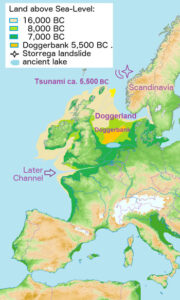Doggerland was an extensive area of land that is now located beneath the North Sea. This massive area of land once connected Great Britain to mainland Europe.
According to a number of geological surveys, Doggerland stretched all the way from Britain’s eastern coast to modern-day Netherlands and the western coasts of Germany.

Archaeologists believe that there are countless artifacts at the bottom of the sea that need to be recovered in order to help them reconstruct what happened over 7,000 years ago. So far, vessels have brought to the surface remains of mammoth, lion, other land animals, and a number of prehistoric tools and weapons.
The area of land inhabited by ancient people was flooded by rising sea levels sometime around 18,000 and 5,500 BCE. Archaeologists believe that the area was a rich habitat for ancient human habitation during the Mesolithic Period.
Archaeologists refer to it as the real heartland of Europe. It was discovered by a team of researchers that include; climatologists, archaeologists, and geophysicists, who mapped Doggerland using new data provided by oil companies.
Divers belonging to the oil companies were responsible for making this incredible discovery. Researchers believe that this ancient land was once roamed by Mammoths and somewhat large human populations.
Recently, British scientists have started using 4D technology to explore this vast area of land in order to understand how it might have looked before it was inundated by rising sea levels over 7,000 years ago. 4D technology will allow researchers to not only find out more about the land but also about territories, colonies, and cultures dating back thousands of years.
Archaeologists believe the area spanned over 93,000 square miles and was inhabited by numerous prehistoric cultures.

Researchers have been able to precisely understand the type of vegetation that grew in the region, as well as what animals roamed Doggerland. Several artifacts have been recovered during numerous diving expeditions.
Researchers have also learned a great deal about the lifestyle and behavior of the inhabitants of Doggerland, and further exploration of the area will surely yield a wealth of information that will help scientists reconstruct this world that was lost under the sea many years ago.
Doggerland was named by University of Exeter archaeologist Bryony Coles in the 1990s after the Dogger Bank, a stretch of seabed in the North Sea in turn named after the 17th century “Dogger” fishing boats that sailed there.
You can learn more about Doggerland by visiting: https://en.wikipedia.org/wiki/Doggerland#Discovery_and_investigation_by_archaeologists







[…] to have existed before getting submerged and lost include Sundaland, Dvaraka, Beringia, Maui Nui, Doggerland, Part of Malta, Strand, New Moore Island, Jordsand, Verdronken Land van Reimerswaal, Sarah Ann […]